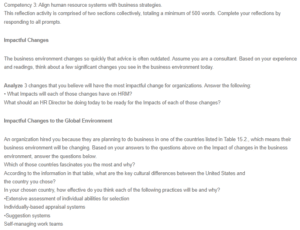Aligning Human Resource Systems with Business Strategies
Impactful Changes
Businesses today operate in a fast-changing business environment, and those that fail to adapt quickly are deemed to fail. Population changes cause everyday changes in the business environment, regular changes in customer trends, and technological advancement. Businesses that fail to adopt these changes will lose touch with the market, hence being locked out of competition with rivals.
The unpredictable business environment has driven firms to adopt data-driven planning models. Human resource (HR) practitioners use data planning models to improve the firm’s value and revenue base (Česynienė, 2008). That includes using data analytics to assess employee feedback and gather critical data about employees. As a result, managers can now collect important information, such as employee morale and the triggers of employee motivation. Analytics provide feedback and business insight that will guide the management’s response to the data. With such information available, managers can improve the welfare of employees, which makes them productive.
Another notable change has been the adoption of remote working. Although remote working is not necessarily a new practice, it was exacerbated by the COVID-19 pandemic. More firms are now shifting from an office-centric culture, although this is mainly in the experimental phase (Česynienė, 2008). One of the significant concerns about remote working that needs to be addressed by directors at the moment is the need for flexibility to avert mental burnout. Some organizations tend to assign their employees more work just because they work remotely.
Also, digital transformation in businesses has had a significant impact on HR operations. However, HR transformation does not occur in a vacuum. It calls on HR practitioners to retrain employees to align with the new working tools (Česynienė, 2008). Employee training drives a sense of engagement on the employees’ part, thereby creating a pool of people willing to work toward the organization’s transformation.
Impactful Changes to the Global Environment
Japan is my preferred country of choice for the new business. One of the most interesting cultural dimensions of the country is the borderline hierarchical culture (Hofstede, 2011). The Japanese are hierarchical-conscious people who act according to the situation but not as extreme as their Asian colleagues. With a reduced power distance, managers will engage with lower-level employees during a training exercise. Japan also scores highly on masculinity, which means that the society is driven by competition and success, which are success factors for an upcoming organization (Hofstede, 2011). Finally, the Japanese society’s high score on uncertainty avoidance means employees always plan for their tasks.
According to Hofstede (2011), one of the key cultural differences between the US and Japan is the degree of individualism. The US scores highly on individualism, which means that individuals prefer to do their tasks independently. On the other hand, Japan ranks in the medium third, meaning that people accept a balance of collectivism and individualism. Also, the two countries differ significantly on uncertainty avoidance, with the Japanese being highly avoidant of uncertainty. On the other hand, Americans are risk-tolerant. Finally, Americans do not tend to connect with the past (not long-term oriented), while the Japanese link with their past (long-term oriented).
Based on the cultural dimensions, it will be easy to assess candidates for recruitment due to their borderline hierarchical culture. It will also be easy to undertake individual-based assessments since the Japanese rank in the middle third in terms of individualism. Additionally, it will also be easy to implement the suggestion system as there is limited power distance between senior-level managers and lower-level employees. The medium score on individualism also means that teams can work towards a collective goal.
References
Česynienė, R. (2008). Globalization and human resource management. Ekonomika, 82, 41-56.
Hofstede, G. (2011). Dimensionalizing cultures: The Hofstede model in context. Online readings in psychology and culture, 2(1), 2307-0919.
ORDER A PLAGIARISM-FREE PAPER HERE
We’ll write everything from scratch
Question
Competency 3: Align human resource systems with business strategies.
This reflection activity is comprised of two sections collectively, totaling a minimum of 500 words. Complete your reflections by responding to all prompts.

Aligning Human Resource Systems with Business Strategies
Impactful Changes
The business environment changes so quickly that advice is often outdated. Assume you are a consultant. Based on your experience and readings, think about a few significant changes you see in the business environment today.
Analyze 3 changes that you believe will have the most impactful change for organizations. Answer the following:
• What Impacts will each of those changes have on HRM?
What should an HR Director be doing today to be ready for the Impacts of each of those changes?
Impactful Changes to the Global Environment
An organization hired you because they are planning to do business in one of the countries listed in Table 15.2., which means their business environment will be changing. Based on your answers to the questions above on the Impact of changes in the business environment, answer the questions below.
Which of those countries fascinates you the most and why?
According to the information in that table, what are the key cultural differences between the United States and
the country you chose?
In your chosen country, how effective do you think each of the following practices will be and why?
•Extensive assessment of individual abilities for selection
Individually-based appraisal systems
•Suggestion systems
Self-managing work teams

